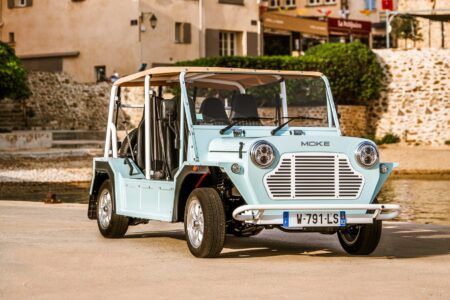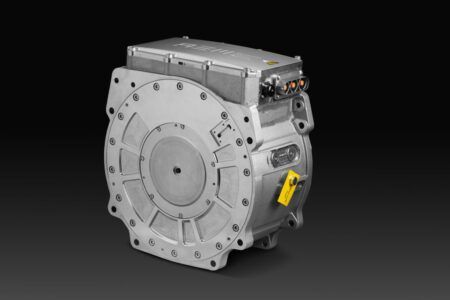From a PHD to Pikes Peak, YASAs axial flux electric motors are electrifying performance cars, and with Mercedes-Benz buying a controlling stake and bringing manufacturing expertise and capacity, YASA’s axial flux motor could revolutionise not just future performance BEVs, but mainstream models, too.
“Axial flux motors are not new, they were invented by Michael Faraday over 200 years ago,” explains Tim Woolmer, CTO of YASA. They have inherent issues, though, chiefly that they’re tougher to manufacture and tricker to cool than a traditional radial flux motor. As such, says Woolmer, that for most applications electric motors are radial flux, with axial flux limited to a number of special applications, though YASA is looking to change that.
Outside, the Mercedes-Benz Vision One-Eleven concept had just been rolled out in front of the assembled automotive press. It’s Mercedes-Benz’s concept of a battery-powered supercar paying homage the revolutionary C111 of the 1970s, not just in its look and colour, either. Its task of exploring future propulsion, though unlike the rotary and diesel engines that would be fitted in its 70’s predecessor, the Vision One-Eleven features motors from YASA, and they’re axial flux.
It was Woolmer’s inquisitive mind that brought him to the room that we’re in in California, at a Mercedes-Benz Design event. YASA was founded by Woolmer, the company a spin-off with Oxford University after the now CTO’s PhD study into electric motors. Woolmer recalls: “Back in 2005 we had a big landmark change with the Kyoto protocols being ratified, which basically meant industrialized nations made a promise to start reducing their greenhouse emissions. Now obviously a big part of greenhouse emissions is transportation, and in 2005 you could not really buy an electric car. I mean there were maybe a couple of very niche vehicles, but basically it was not possible to buy an electric vehicle.”
That had Woolmer set off down the path of his PhD, which he says, “Was really to take a blank-sheet-of-paper approach on electric propulsion technology and say, What kind of motor would be great for the electric vehicle market, assuming it was going to exist in 10, 20 years?” As he explains, the answer wasn’t a new one as Faraday got there first, but Woolmer’s work, and subsequent setting up of YASA would result in the company designing, and manufacturing, axial flux motors.
 State of flux
State of flux
“As you get to do on a PhD, I got to go back to the academic literature,” says Woolmer, “And I found there were some great benefits of axial flux machine. The literature back in the early two thousands talks about better torque density, better power density, and with less weight, less volume, so it looked like an interesting place to go and really take a fresh look and see really has anything changed, any new materials, manufacturing technology that might mean that we can solve some of the fundamental problems associated with them. An axial flux machine and a radial flux machine are very similar in the sense that they use copper, iron, and permanent magnets, so the fundamental materials and the principle by which they work are identical, but everything else is completely different.”
Specifically, Woolmer discusses the difficulties of manufacturing, and the commercial viability as a result, as unlike a radial motor the laminations cannot be stacked, while cooling, which is vital for sustained, repeatable performance, as well as the complex winding all presented issues. Woolmer would find a solution to old problems with a new material which was becoming available in the late 1990s called soft magnetic composite. Woolmer explains: “What it [soft magnetic composite] is basically a powder which has a coating on it, and you can press it and create almost like a three-dimensional lamination. So instead of having quite a complex process to make the magnetic component here, we have a quite simple one with a single press operation. And this was a real enabler for getting the first axial flux machines in the market.”
Naturally, it’s not quite as simple as that, with the soft magnetic composite material needing a lot of pressure to make the parts, though at the time Woolmer was researching it, the stator would have required a press of around 4,000 tonnes to produce a stator big enough. He explains: “We kind of had to think a bit creatively to say, OK, keen to use this material because it helps with axial flux, but we can’t make a stator big enough, is there a way of segmenting the stator in a way that can utilize the material but also make something big enough to be a traction application. And with necessity being the mother of invention that triggered a whole new idea for a topology, because we’ve got these two rotors and we’ve got flux traveling straight through the stator. Doing so means we get rid of this stator yolk, and you are left with these segmented teeth. We then we reconstruct having lost this stator yoke that holds the machine together, we create a new structure that creates the building block for the machine.”
 More for less
More for less
That design brings several advantages, not least weight reductions. The YASA motor like-for-like seeing the output of a 50kg radial motor in an axial one of 20kg or less. There’s also higher torque density and reduced electrical consumption, with these bringing a multiplying effect via reduced mass throughout the entire vehicle architecture. The soft magnetic composite material also allows relatively low-cost pressings of a wide variety of three-dimensional shapes, with producers and the material itself being readily available worldwide.
Early days of YASA would see the company prove its motors in motorsport. “We got involved in all kinds of crazy projects,” says Woolmer. “One of my favorites was in 2015, we helped build up a powertrain that was more than a megawatt – which is a lot of power – 1500 horsepower to take on the Pike’s Peak race in Colorado. It had been won every year by combustion vehicles, supercharged turbocharged, and people looked at this electric car and it smashed the field. That for me was a real turning point in the way people perceived electrification, not just in motorsport, but rippling through an automotive.”
To achieve that level of performance, and, crucially, sustain it, Woolmer admits that the cooling issues related to axial flux motors needed to be addressed. “All electrical machines struggle with that continuous to peak power ratio,” he says. “Typically, in a radial application it’s about 50%, which means if you’re pushing the machine hard, you’re doing multiple acceleration events, and you start to get de-rating, a bit like brake fade on a racetrack. Because the heat path in a radial motor is out through that stator yoke, which is a big lump of iron. We didn’t have a big lump of iron, so we really had to turn the problem on its head. It’s one of those classic engineering moments where you’ve gone from, ‘we’ve created a problem’ to ‘we’ve solved it in a way that’s a massive improvement on the original design’. We created a sealed structure around the segments with some features in it to fill it with oil. This oil flows in a zigzag pattern on top and around those coils so that every single component that creates heat gets a 360 direct contact with the coolant.” That means the axial flux machine can generate a high continuous power, while also bringing packaging advantages due to shrinking size, Woolmer saying these are in the region of 65-70%.
Naturally the promise of abundant, repeatable power in a compact package would attract the interest of automotive OEMs, with Ferrari using YASA motors in its hybrid Stradale SF90, and more recently Lamborghini admitting its new Revuelto flagship uses YASA’s axial flux motors along with a 6.5-litre V12 petrol engine. It’s the link to Mercedes-Benz which is most significant for the YASA, as Mercedes-Benz didn’t just become a customer, instead it is buying a controlling stake in the business. YASA will continue to provide other manufacturers its axial flux motors, with Woolmer explaining: “in our Oxford plant we are producing tens of thousands of motors most years, it’s quite a niche plant and that will be used to supply third party companies.”
 The scale of success
The scale of success
The motivation for Mercedes-Benz to buy such a revolutionary company is obvious. The company had been working already with YASA in relation to an electric motor for a future sports car product. But why YASA would want to be bought is another question. Woolmer answers that, saying: “YASA was at the stage where to scale up into production of the hundreds of thousands you’d be looking at hundreds of millions of capital to build factories and there becomes a point where it’s just not efficient use of capital, so it made more sense at that point to partner. Of course, there were a few options that we had, but the partnership was for the engineers. It was a dream and a great company to find, the synergy with Mercedes was really, good.”
Mercedes-Benz/Mercedes-AMG input will see YASA axial flux motors produced in numbers not possible until now, with an existing plant in Berlin being used to scale up production, with Mercedes’ competency, process development, quality, and history in mass production, for full BEVs, opposed to just hybrid applications, being significant. There’s a BEV sports car in the pipeline, and Mercedes-AMG will use YASA motors in both hybrid and full BEV spheres, with Mercedes-Benz’s production capacity and expertise costs and complication will continue to drop, to the point where mass production is viable.
Significantly, the axial flux motor’s size presents an incredible opportunity, with the potential for in-wheel motors, their size and weight being advantageous in relation to car packaging and design. Tantalisingly, too, Woolmer admits the motors we’ve been looking at are already five-years old. “Of course, there’s another step as this technology continues to improve,” he says. “If you look back over the last 10 years, we’ve managed to increase the power and torque density by a factor of 10. In a decade, that’s been our roadmap. And over the next three or four years, we’re going to see that double again. So, we’re getting to the point where we can start seriously thinking about putting this technology either very close to the wheel, or even inside the wheel. Which is exciting – not just having a small impact on a vehicle but potentially fundamentally altering the architecture and the way vehicles are designed.”





